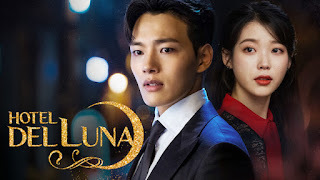C. Litka's Blog, page 38
January 8, 2022
Writing vs Reading

It shouldn’t be writing vs reading, but it is for me. I haven’t read all that many books since writing has taken over my creative life. Most of my wall of books I acquired prior to 2000, and I haven't purchased or read all that many books since.
I suspect that this isn’t the case for most writers. Most writers read a lot of books even while they are writing. Nathan Lowell said in a recent blog post “Reading is a necessary key to writing for me. Over the years I’ve learned that if I’m not writing, I’m probably not reading.” And I know of other authors – indeed all of the ones I know, who can both read books and write books, walk and chew gum, at the same time. But for me, it doesn’t work that way. Oh, I can read and write, but I have to say that over the last decade of writing, I don't feel the need to read books.
There are several reasons for this. One simple one is that I couldn’t find new books that I enjoyed reading. This fact was one of the motivating factors for me to get serious about writing my own books. This is due, in part because over the years I’ve developed a very narrow taste in stories, stories that, for the most part, they don’t write anymore, at least not in the way I enjoy. I've long considered myself a fan of science fiction. The reality is that I read mostly space operas and planetary romances. They don’t write planetary romances these days, and space operas are, for the most part, military sf stories. Plus, I find that many of them are thinly disguised fan fiction of TV shows and movies on one end of the scale, and on the other end, massive techno-jargon epics on a vast scale, with few, character focused stories in between, which would be my sweet spot.
My major problem with modern fiction is that I hate the modern fad of telling stories with multiple points of view, and lots of them. I also dislike multiple flashbacks as well. When I pick up a book, I want to read a narrative, not put together a jigsaw puzzle in words. All this slicing and dicing makes me suspect that the story is seen as simply too plain to tell without artificially making it complicated and confusing. So, given my limited tastes and current fads, it’s not surprising that I have a hard time finding modern books that I really enjoy reading.
The other factor keeping me from reading books, is that I spend a lot of time, ideally, anyway, daydreaming up my stories and I don’t want other stories seeping into those daydreams. I use the time I might spend reading daydream up my story, scene by scene throughout the day and when I wake up at night. I go over and over them again slightly altering them until I’m satisfied. And even then, I will probably make minor changes when I set them to words.
All that said, I am hoping to read more this year. I’ve already posted a number of book reviews, and I just tried and DNF’ed two more books: Mike Brooks’ Dark Run at the 24% point – I didn’t care about the characters and I found it to be too much of a Firefly fan fic. The other was Peter F Hamilton’s Great Northern Road at the 10% point. The Hamilton story was about the polar opposite of Dark Run, with way too many points of view characters, way too many minor scenes that ran way too long. I found myself skimming whole pages, and with 800+ to go I decided not to go on. I have a couple more books on order from the library. We’ll see if I can find one I like.
In the meanwhile, I am daydreaming up a new story. Don’t hold your breath, however. I had started two writing projects this fall, the sequel to Keiree, and another Nine Star Nebula Mystery/Adventure story. But in both instances, I ran out of story ideas and lost interest in them. The thing is that I really want to write a longer, more ambitious work. I spent all summer fruitlessly thinking about and daydreaming one up, but I couldn’t get a story out of it. What I’ve done now is combined the world I created this summer with a plot from another failed story idea, and I think I might be able to get this hybrid idea to work. I have a lot of daydreaming to go, but since I’m enjoying my daydreaming. It’s not work. I don’t want to work. However, I’m in no rush to get it written. I won’t put it into words until I have the story solidly entirely “written” in my head. I don’t want to have to stop in the middle of the story to invent what I want to do next as I have been doing in the last several books. So, if everything goes well, and that’s far from a given, any book that comes out of this certainly wouldn’t be ready for release until late fall 2022 at the very earliest, but it may well end up being my 2023 novel. I want it to be good. I want it to be my best. I am going to take my time with it.
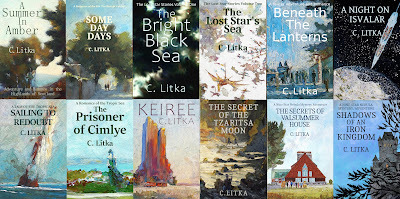
January 1, 2022
Leviathan Wakes by James S A Corey A Review
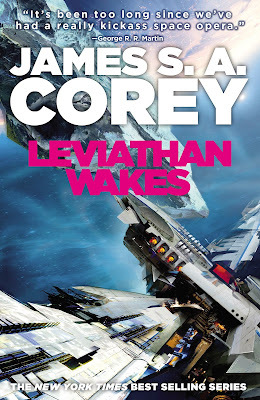
Each November I teat myself to a new tech device. This November that device was a Kobo Libre 2 ebook reader that I purchased mainly for reading ebooks from the library. Which explains the flurry of book reviews on my blog.
The reviewer’s bias: I prefer stories with well developed, pleasant characters. I like writing that is clever and witty – entertaining in itself. I prefer first person narratives, or close third person narratives. I dislike thinly disguised fanfic and stories with gaping plot holes.
Well, I finished Leviathan Wakes, so it is at least okay. I enjoyed it more than Network Effects in that its characters were more fleshed out, and relatable. It was written in close third person, which is my second favorite style of writing after first person narratives. However, jumping between two points of view at critical points in one narrative is, in my old fashioned opinion, a cheap way to keep readers involved in the story. I tolerated that aspect of the storytelling.
However, upon finishing the story, I’m clearly going to need someone to explain the story to me. since it seems to me that, upon reflection, the story has a lot of moving parts that don’t seem to really connect together, though the story seems to imply that they should.
For instance; is the story about the war between the Outer Planets, Mars and Earth? Or is it about an evil corporation discovering an alien virus and perpetrating a horrendous experiment? And if both, how are they connected, or are they even connected? They don't need to be connected, but I got the impression that they are. Somehow.
It seems to me that the experiment on Eros could’ve been conducted much simpler without any war at all. (Just ship the alien virus in, stage or sabotage a nuclear accident to introduce the radiation, and let the zombies spread it through the asteroid. And you still could’ve had your detective story.)
And there are plenty of smaller questions that either I missed or were not answered. Questions like, who brought the alien virus to Eros? Was it the Mao gal or someone else. If it was the Mao gal, the timeline between discovering her and the outbreak seems pretty compressed. And pretty iffy.
Or why did the evil corporation’s ship attack the courier ship? Why did it set it up as a trap to lure another ship to the rescue? How could anyone be sure that the little clue in the transmitting radio pointing to the Martian navy ever be discovered, much less broadcast to the solar system, and anyone would jump to the halfcocked conclusion that the Martian Navy was behind it? And even so, that little clue would be enough to start a war? That alone seems to be a very long stretch.
What actual role in the story did the Outer Plant/Mars/Earth war actually play in the book? Was it just in the background to set up further books, or was in somehow central to this story. If the story is about the alien virus, the war would be unnecessary. And if it was for the eight books that have followed, why not introduce the war in the following books?
And why the stupid ending? A hard sf book suddenly changes into what? Science-fantasy? Why have an asteroid becomes a magical thing that moves, without inertia, at vast speeds with no apparent mechanism, or any apparent way that such a mechanism could’ve been developed by the organism. It seems like a half-assed way to get out of corner you’ve painted yourself into.
In conclusion – it was an okay read. I dislike grand scale stories, so that counts against this story. I'm not a fan of grimdark and what seems to me to be needles violence. But on the positive side, they did write relatable characters that balanced out the negatives. However, I do have to say that the story was overly long and it got a bit tedious at the end. All in all, I will not be continuing with the series.
December 27, 2021
Network Effects by Martha Wells Review
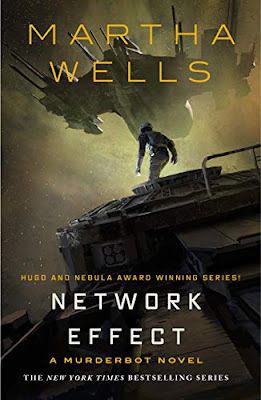
The reviewer’s bias: I prefer stories with well developed, pleasant characters. I like writing that is clever and witty – entertaining in itself. I prefer first person narratives, or close third person narratives. I dislike thinly disguised fanfic and stories with gaping plot holes.
Network Effect won the 2021 Hugo Award for best novel. Murderbot won the 2021 Hugo Award for best SF series. Artificial Condition won the 2019 Hugo award for novella. All Systems Red won the 2018 Hugo Award for best novella.
Murderbot stories are popular. Everyone loves Murderbot.
I found Network Effect to be okay.
Murderbot is an original and entertaining character. It is also the first person narrator of the stories. The thing with first person narrators, as a writer who uses them, is that they narrate the story from their perspective within the story. They tell the story as they see it, they tell what is important to them. And they tell it as they want to. In short, good first person narrators stay in character. Or more accurately, a good writer keeps his or her first person narrator within the story and the character. Wells keeps Murderbot within its character, which is good – until its not.
For me the Murderbot stories fall off a cliff as soon as you get beyond the internal dialog. I’ve identified several reasons for this. The first is that Murderbot doesn’t much care about scenery or mood, and so both are lacking in its narratives. To be honest, the stories generate little to no visual imagery in my mind. For the most part its just a series of corridors and doors – an interior dungeon and dragon landscape that I can't seem to picture. For example, in this story I have no idea what the space ships look like. Or what sort of platform could float on water, have decks to greet traders, fly into space and become an intricate part of another space ship. And it seems that for Wells/Murderbot, it doesn’t matter. While she does set out some details of settings, they just don’t seem to gel for me to create an image in my mind. They may work for other readers, but for me, they’re just a string of techno-jargon words that can be ignored because these sorts of details apparently aren’t important to either Wells or Murderbot.
Which brings me to my second problem with these books. The story structure is a loop of the same elements slightly rearranged every time the come around. Danger. In response, Murderbot use drones, hacks systems, gets semi-destroyed, but at the end of the loop, saves its clients. Again and again within the story and within series as a whole. Reasons and details may change, but given the limited narrative focus of Murderbot, it all just blurs together. And gets old.
The third issue is that the human characters are more or less interchangeable. While she does make an effort to make them distinct, you’d have to be paying very close attention to them to notice that, since, after all, they’re all only minor characters. It’s been a while since I had read the first three novellas, so I wasn’t up to speed who was who when starting this novel, and I don’t think it would’ve made any difference to me if I had read the stories back to back.
The fourth issue, a minor gripe, but still... I have a problem with the mega-setting. Everyone’s an indentured worker of one corporation or another. Whole planets of indentured workers? I know that its a popular concept these days. I’ve run across it before, but I doubt that its possible. And even if it is, it’s an unpleasant world to spend time in.
So to sum it all up for me – while it may be a failure of my imagination to attach images of locales to descriptions in the book, the repetition of the same plot over and over again has made Murderbot, despite being an interesting character, become a rather tedious read for me. I couldn’t wait to finish this book and that’s not good. A good story is one that you don’t want to end.
Still, I will be the first to admit that the perceived failings of Network Effect may be mine rather than Martha Wells. Indeed, given the popularity of the series, this is likely the case. Oh well.
While there is a one Murderbot novella out that I haven’t read, which is set before Network Effect, that may describe the basis of the flashbacks told in this novel, I think I’m done with Murderbot, even if TOR offers any more Murderbot books for free.
December 22, 2021
Happy Holidays!
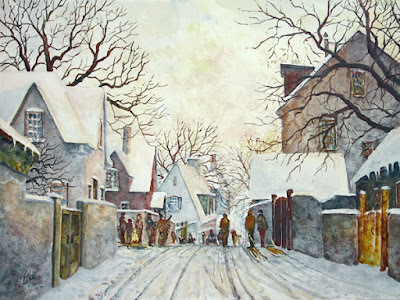 Sledding in Pangone by C Litka
Sledding in Pangone by C LitkaHope you and your loved ones have a wonderful Winter Holiday, whatever you celebrate, and an even better New Year!
December 17, 2021
A Tale of Two Tales
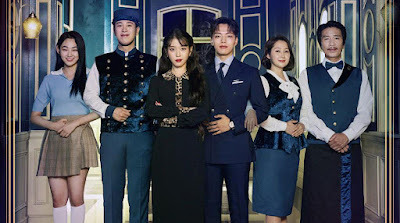 Staff of the Hotel Del Luna
Staff of the Hotel Del LunaComments on Cowboy Bebop and Hotel Del Luna, two recent Netflix series.
I recently watched two tv shows on Netflix, four episodes of the science fiction series Cowboy Bebop and so far, 14 of the 16, episode Korean fantasy show Hotel Del Luna, and they couldn’t be more different.
Cowboy Bebop is a sf space adventure with the premise of, you guessed it, bounty hunters in space. Besides alien invasion, what other premise is there for a tv sf show? It is the live action version of an anime show featuring two losers as main characters. One is a cop who lost his job and wife, and the other is a criminal who lost this job in the syndicate and his girl. The ex-cop is responsible and relatively competent, the ex-criminal is cool and incompetent. But did I mention that he’s one cool dude? The basic show format is that every episode the pair go after a Batman (The TV show) type villain to collect a bounty, They usually screw up. The show has already been axed by Netflix. Critics said that it had poor pacing. It actually had none, as far as I could see. It was a sliced and diced series of scenes with the characters’ backstories slipped in whenever they ran out of dialog or in an attempt to extend the tension of the episode's main story line. Plus, as critics also noted, they weren’t spending their production money on sets. Most outdoor sets looked to have been filmed either in a back ally, or on some old movie studio back lot. They didn’t even look retro/cyber futurist.
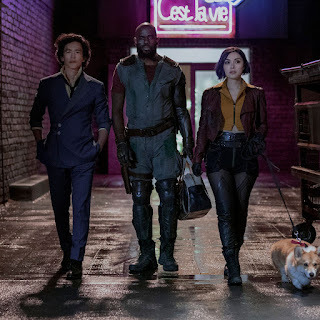 Main Characters of Cowboy Bebop
Main Characters of Cowboy Bebop
As usual with TV sf, there were dumb things to serve the action sequences. Like the opening action scene where a hole was blow in a space station, and everyone was being sucked out into space. They have to reach a switch to activate a patch to seal the hull. Even without wondering how the patch could be applied at the exactly the right place, the fact that it had to be triggered manually is senseless -- any sort of patch would need to be automatic to work. Just nick picking. Or take a rooftop fight scene set on Mars. With Mars having only 1/3 the gravity of Earth, you could’ve filmed a semi-realistically flying ninjas fight like you see in any kung-fu movie. But no, it was a very choreographed, dance-like sequence. And did I mention a powder that turned people into trees? Yeah, that too. Character development was on par with its comic book origin.
It will not be missed. We’ll just have to await the reboot of Firefly that I gather is in the works. That was a dumb show as well, but done a whole lot better, mainly because it had more fully fleshed out characters, I enjoyed it, despite how stupid it often was.
Turning now to Hotel Del Luna, we find something completely different – Korean fantasy/soap opera. I believe that when it was first shown in Korea, the episode length was probably different, so that in its 16 episodes you get something of a mishmash of story lines that might have been more episode-orientated in its original format. The premise of the show is that the Hotel Del Luna is a hotel for ghosts – souls who have either lost their way to the afterlife, or have hung around on Earth because of some unfinished business they feel they must attend to. The basic structure of the story are the various ghosts and their issues which must be solved for them to continue on to the afterlife and eventual reincarnation.
The main point of view character is a fellow who’s childhood and expensive education was financed by the owner of the Hotel Del Luna with the understanding with his father that once he came of age, he would take over the management of the hotel, at least as far as dealing with the real world, which the hotel has one foot in. The hotel owner is a thousand year old ex-bandit woman, who is paying for her evil actions as a bandit. Her punishment is that she’s tied to the hotel and denied entry into the afterlife, somehow redeems herself. She and the new hotel manager make up the long drawn out main romance story at the center of the show. There is also a trio of employees of the hotel, and the hotel manager’s outside friends who are also woven into the story.
I am totally unfamiliar with the religion(s) of Korea, but the story line seems to be a mishmash of various religious and folk believes, that serve whatever story line the show writers come up with. I’m not sure they make much sense. You just have to go with the flow. The ghosts are people in makeup and look pretty tacky, and the scary parts, are likely not too scary, but then, not being a fan of horror, I’m not one to judge how scary the scenes stack up. There is some blood, but not the gore true horror/action movie fans have likely come to accept/expect. Outside of the ghosts, the production values are up to the typical high Korean standard.
 The Hotel Luna unseen by the living
The Hotel Luna unseen by the living
I’m not into film, so I’m really not one to judge acting quality. Korean (and Chinese) shows have their cultural quirks. That said, the acting in this series is somewhat of a mix of good and bland. I've found that the typical romantic lead in Asian shows is a guy who stands around looking serious without saying much. And this can be dragged out for half a minute with the characters just starring at each other wordlessly. If they would actually say what’s on their mind, you wouldn’t need 16 hours plus to tell their story. Drama/melodrama, I guess. In this show in particular, they often have the lead characters in slow, extended dialog just standing facing each other, about four feet away, hands at their side, with all the animation of a department store manikin. Really. Maybe that’s a Korean thing, but you’d think that you’d want some sort at business going on as they talked as well – walking, occasionally gesturing, looking away from each other, whatever. Maybe it’s just easier and quicker to film these scenes standing still talking, as these shows are often still being filmed even as the first episodes are being aired. And of course with all these Asian shows, the first hug, the first kiss takes five minuets with a lush soundtrack to accomplish. Watch enough Asian shows and you come to expect that. And as a bonus every Asian show has at least one scene where someone administers first aid to the the person they're in love with, so show how much they care for them. Oh, and they all have close ups shots of the characters clenching their fists when they’re mad or stressed. You could probably make a drinking game out of these scenes.
So with Hotel Del Luna we have a rather silly premise that I think it plays rather fast and loose with to serve the plot. A ghost or two with problems to be solved in each episode. Usually there are flashback to the time where the Hotel Owner was a bandit that piece by piece builds the back story of the reason why she’s being punished. And this slow burning romance between the two leads.
 The ex-bandit owner of Hotel Del Luna
The ex-bandit owner of Hotel Del Luna
The thing about Hotel Del Luna, unlike Cowboy Bebop, which has its story serve as a link between action sequences, is that Hotel Del Luna tells not only an intricate core story and romance, but weaves all sorts of other stories in and out of it. Supporting characters all have backstories. And each ghost has a story as well. Plus the main story lines -- Hotel Owner's tragic romantic past and present reluctant romance. Unlike Cowboy Bebop, it has characters who are more than just cool. Characters you can come to care about. Let me repeat that. It is a story with people that you can come to care about. Cowboy Bebop’s characters are mostly light, enigmatic sketches, probably because of the medium the story is drawn from – animated comic books. Having true characters is, for me, what makes all the difference in the world when it comes to enjoying a story in any medium. And for that, I’m willing to give its sometimes silliness a pass.
Is Hotel Del Luna great? No, I could recommend maybe half a dozen better Korean shows. That said, it was still well worth an hour plus of my day for a couple of weeks. (I still have two episodes to go...) On the other hand, the four hours I spent with Cowboy Bebop were spent hoping that it would get better so I wouldn’t have been wasted my time watching them. Reviews said that they did get better near the end, but by the end of the fourth episode, I no longer cared, so I did not finish it.
December 10, 2021
Mini Reviews of Free Books
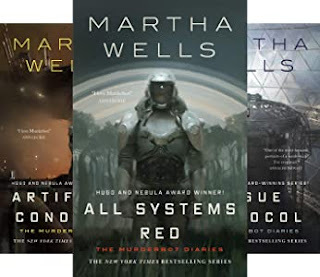
If you agree to receive TOR Publishing’s promotional emails, they will offer you a free ebook every month or so. Usually the books offered are related to that particular author’s newest release. I signed up a year or so ago, and thought I’d just write mini-reviews of some of the books I’ve received through this program – in alphabetical order of Author.
Victories Greater that Death by Charlie Jane Anders. This is a YA or a Middle School sf title, I’m not sure which. It has a high school girl as the main character, which almost seems to make it a middle school story. There was nothing in the first chapter or so that I read that seemed inappropriate for junior high readers, at least judging from the fantasy books my granddaughter reads. I’m not into YA, or middle school books -- the writing is too simple, and HS characters don’t appeal, so I called it a day after the first chapter or so of this book.
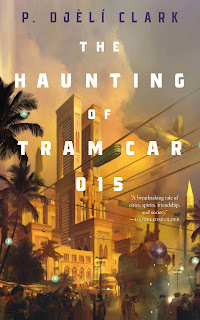
The Haunting of Tram Car 015 by P Djeli Clark This novella was... okay. Set in an alternate history where supernatural beings have been released into the world, to aid and annoy people, it had an inventive premise and world building – a lot of promise. But seeing that it was only a detective story novella, it would be hard to fully realize the full potential of the premise. And I don’t think it quite did. We’ll see what he does with full novels set in this world. (On an unrelated note, why is this paragraph's spacing different than all the others, seeing that it is just one of the paragraphs in the whole essay that I copied and pasted onto the blog page? It's a mystery to me. The working of a Jinn?)
Tooth and Clawby Jo Walton A story with dragons as characters. I didn’t connect with the characters, which is important to my reading experience. Called it a day after a chapter.
Hammers on Boneby Cassandra Khaw Another novella. It featured such an over-the-top hardboiled PI story writing style that I didn’t know if it as meant to be read as a satire or straight. In either case, it was annoyingly badly written. All of the characters, including the PI narrator were unpleasant. I don’t spend my time with unpleasant people if I can help it. Quit reading at the 20% mark.
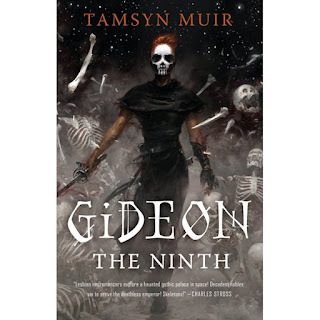
Gideon the Ninthby Tamsyn Muir I actually believe that I read the first chapter on the TOR website when the book came out, and only downloaded the complete book when it was offered as a free book just before the release of the second book in the series. Much talked about. Very weird. I might give it a bit more rope at some point. Or not.
A History of What Comes Next by Sylvain Neuvel The introduction has the narrator killing her loving husband of 20 years on a transatlantic ocean liner by sticking a pen up his nose and into his brain and throwing his body overboard because he read something he wasn’t meant to read, discovering what she was (a mystery). If this is the type of (cheesy) intro that hooks you into a story, this may be your type of book. It repelled me. As I've already said, I don’t care to spend time with unpleasant people in life or fiction.
The Way of Kingsby Brandon Sanderson. I’m not much of a lad for fantasy these days. This one starts out with a prologue set on a bloody battlefield with some immortal warriors, and then jumps 4,500 years forward to recount an assassin's attempt to kill a king using magic. Another book with an unpleasant character as the main character in the first chapter. Not my thing. Plus, I can’t help but think that if you allow magic in a story, you can make up anything you want or need for your plot, because, you know, it’s magic. That’s not my thing. I like some underlying basis of reality. DNF this one at the 1% mark (but its a long book...)
Murderbot, the first 3 novellas, by Martha Wells. I reviewed these stories in some depth some time ago, so I’ll just say that I enjoyed them, not as much as many people seem to, but they were the best of the lot so far. Have the first novel on order from the library.
The Traitor Baru Cormorant by Seth Dickinson Another fantasy novel in which I didn’t connect with the characters. Plus, I gather that the story is one of those grimdark ones, so I called it a day after a chapter or two.
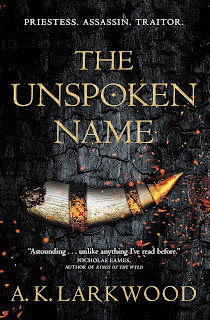
The Unspoken Name by A K Larkwood Yet, another fantasy. Clearly fantasy is far more popular than science fiction, given the samples TOR gives away when publishing a new story by the author. In this case, I read the first chapter and put it down, undecided. I’ll give it some more rope, but I just haven’t felt any great desire to return to it yet. We’ll see.
I still have a number of books to sample, but nothing very enticing. There are a couple more fantasy books, including Gardens of the Moon, by Steven Erikson, which I gather is another big name in fantasy. Plus some YA titles that are probably not worth my time.
As you can see, I’m a very fussy reader – darn hard to please. I have, however, downloaded a lot of old books from the Gutenberg Project, as well as my own books, on my new ebook reader so I do have a lot of potentially enjoyable books choose from.
December 3, 2021
My 2021 NaNoWrMo Effort Wrap-up
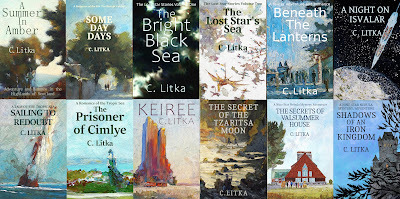
This year, for the first time ever, I decided to give NaNoWrMo (National Novel Writing Month) a go. I had taken the summer off from writing to come up my next great novel – without any success. So without that novel to write, I opted for Plan B – a return to Mars with Molly and Mons with a novel length story that would continue their story. I wrote the opening 8,000 words of that story before deciding that the story I was writing wasn’t going to work, or perhaps wasn’t the direction I wanted to take them in. However, I didn’t have an alternative direction in anything more than a vague alternate idea, so I abandoned writing that story it mid-September. In October it was on to Plan C.
Plan C – the any port in the storm plan, anything to write during the long Wisconsin winter project – evolved during the month of October into a new Nine Star Nebula Mystery/Adventure story. I had planned to give that series a rest, but as an any port in a storm story, I hammered out a rough plot. I came up with a mystery, another pirate prince villain, with an outline of action, and an ending that I am quite happy with. It looked to be a go. So with National Novel Writing Month approaching, I decided to use that as a motivator to get started writing.
So how did it work? The short answer, not very well. While I never actually intended to write the entire first draft of the novel in the month of November, I did hope to get at least half of it written. I fell significantly short of that goal. I did write 17,000 words, which is something – a beginning. But it’s still far short of the 50,000 word novel, or even the 25-30,000 words I would’ve like to have written in the month. So what happened?
I am of the school that if you want to get a book written, you sit down and write every day until it is done. Unlike most authors, I don’t use word count goals. Rather I’m content to put in 1/12 to 2 hours every morning, and if things are going well, an optional hour or two in the evening. I save each day’s work as a separate file so that if I screw something up, I only lose a day’s work. Thus, my files tell the story of my faltering efforts at this book. I have a file for every day until the 17th of November. My next files were dated November 23rd and 24th, and my next file after those was November 29th. Doing the math, you’ll see that I spent 20 days producing 17,000 words, less than a 1,000 words a day, on average. That number is a bit misleading in that probably half of those days I spent going over what I had already written rather than forging ahead. This is common practice for me these days when I’ve outrun the story in my head. If I can’t go forward, I go back to do a second or a third pass over what I’ve already written rather than writing nothing. Of course there were days when I was writing nothing -- or these blog posts -- as well… But, well… I’d reached a gaping hole in my plans. And I’ve yet to fill it.
I found that the outline I had in my head would make a good novella – a 30-35,000 word story, but not a 50,000+ word novel. Novels in this series run more in the 60,000 words plus range, but I’ll settle for 50K story. But not for a 35K novella. Essentially, I discovered that I was missing act two – I had a beginning written, and the fast paced ending in my head, but was missing the 20K word middle act. I’m always tempted to make it too easy for my heroes, so I usually need to find more ways to throw sand in the gears – to give them more stuff to overcome. I’ve got a couple twists and turns at the ending that I’d like to get to, but now I need to find something for them to do – 20K words more to do -- than I had originally planned, before I get to the ending scenes that I do have planned out. I’ve settled on a location for the second act, but that’s about all. As of this writing, I’m still not pushing ahead until its all settled in my mind.
Alas, that’s the story of writing these days. I don’t spend the time daydreaming the story over and over again until its major scenes are clear in my head like I may’ve with my first books. Instead I set out with an idea for a beginning and an end, but with only a vague middle act in mind, so that, when I reach it, I must stop and actually figure out what I need and want to do. Oh well, we’ll get it done sooner or later. However, I don’t think I’ll attempt a NaNoWrMo again. It isn’t my style.
November 26, 2021
Naming Characters
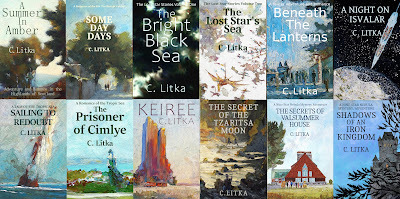
Hannes, a friend and beta reader of mine recently suggested this topic, and at exactly at the right time, since I was at a complete loss as to what to write about this week. The topic is, how do I choose names for my characters?
The short answer is that I stare at my keyboard for a while and pick out a starting letter, and add a few more until it sounds right. There are, however, three more personal rules that determine how a character gets a name in my mind.
My first rule is that a name should be easy for English speaking readers to pronounce. We earthlings speak many languages and in making this rule, I’m not elevating English above any other language. It is just that most, though far from all, of my readers speak English as their first language, so it makes sense for me to give my characters names that use familiar, English, letter patterns that they can easily put sounds to.
My second rule is that I want my names to be short and snappy so as to not bog down the narrative flow. The use of long and strange combinations of letters, can break the narrative voice in the reader’s mind, bringing the story’s flow to a brief halt as a reader tries to put a sound to it. I realize that strange names are often included in speculative stories to indicate a non-human character, but I don’t write aliens – at least the ones that speak. In other genres unfamiliar, non-English names, are given to indicate ethnicity, which brings me to my third rule.
My third rule is that, since most of my stories are set in the distant future and on planets long removed from contact with earth, l don’t want to give my names any strong ethnic connections. Even on the earth of my stories, those ethic distinctions have long since been lost. I will, however, include some traces of ethnic names in some of my names, though they will be short and snappy when I do.
This desire for short and snappy names often gives some of my characters names that look a bit like Chinese names. Sometimes this is deliberate, but most times, it’s just a matter of keeping them short.
Often times, the names I choose also invoke memories of characters I’ve run across in my life.
Take Wil Litang for example. Wil is short for Willie, my favorite farm dog that my grandparents owned in my distant youth. Li is the most common family name in China, and Tang is the Western name of a Chinese dynasty, so that Litang recalls China, without being exactly Chinese, Plus, the “Li” or “Le”, also gives it a French flavor if spoken out loud. The idea is to mix and match ethnic references.
Now take Naylea Cin. Cin is a play on “sin” since she is a thief and assassin of the mercenary order of Saint Bleyth. I had toyed with the idea of finding a historical saint to name the organization after, but in the end decided against that, as it might be overplaying my hand by having an assassin working for an order named in honor of a known saint.
In the case of Sella and Lessie Kaah I choose the name of Raah as a deliberate nod to the Indian subcontinent. Lessie was my second choice for her name. I wanted to call her Lessa, so it would be Sella and Lessa, but Lessa is a significant character in another fantasy series, so after some debate, she became Lessie instead. Usually I prefer to use the more formal, family name, in my non-dialog text for each character, rather than the character’s given name, but in the case of the twins sharing the last name, it had to be their first name for both dialog and description. In Taef Lang, we have an English sounding last name, with a made-up first name. Lang is a call back to Lang, the narrator of Islandia, by Austin Tappen Wright.
Rafe GilGiles (and his younger self, Rafe d’Mere) are a homage to Jack Williamson’s poor old Giles Habibula in his The Legion of Space. Rafe is a nod to my favorite classical music composer, Ralph Vaughan Williams, who preferred to be known as “Rafe.” The “Vaun” in Vaun Di Ai refers to “Vaughan” Williams.
Botts is a one name character designed to sound like “Jeeves,” the role he plays, as does that other sentient machine, “Mactavish.”
Ren Loh owes her name to a character in the Taiwanese TV series “Office Girls” with its lead female character named Xing-ren that I am very fond of.
In my first two books set in the near future, I did use names to imply ethnic backgrounds. For example, Selina Beri -- Selina comes from the story “The Twenty-first of October” by Kenneth Grahame. In it Selina is a young lady who lets her enthusiasm for the English Navy and Admiral Nelson get her into trouble. Beri is a short, English sounding, Indian family name, as her ancestors came from India, as is Hugh Gallagher’s roommate, Omar V Shinge. I used “Alasandr Say,” for my Summer in Amber narrator, as it sounded English but is actually a Russian name, as I envisioned his Russian ancestors settling in England a generation or two before. Nesta Mackenzie is Scottish, as her name implies. I came across the name “Nesta” in the delightful first chapter of Erskine Childers’s “The Riddle of the Sands.” (One of my favorite chapters in all of my reading.)
So while my choice of names does reflect past readings and interest, when it comes time to invent a character’s name, other than a leading character's name, it involves little more than staring at my keyboard and deciding on a letter to start with, and then adding a few more to finish it off. Beyond that, I can offer no science or secret to share when it comes to inventing names.
November 18, 2021
Summer In Fairacre by Miss Read
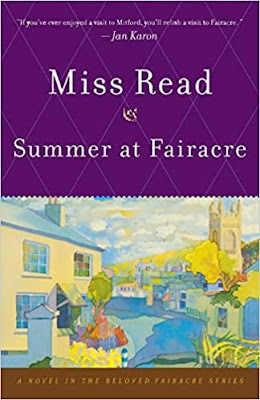
The reviewer’s bias: I prefer stories with well developed, pleasant characters. I like writing that is clever and witty – entertaining in itself. I prefer first person narratives, or close third person narratives. I dislike thinly disguised fanfic and stories with gaping plot holes.
As I mentioned in some recent posts, I read some books set in the everyday life of England of the last century by D E Stevenson and Miss Read a few decades ago. I have reviewed the Miss Buncle Books of D E Stevenson here. Along with the Stevenson books I ordered up some Miss Read books from the library. This is my review of the four books I picked up, but will focus mostly on, Summer at Fairacre.
Miss Read is the pen name of Dora Saint. Her father was a schoolmaster, and she followed in his footsteps, training as a teacher at Hometon College, Cambridge and began her teaching career in 1933 in Middlesex England. She married in 1940, and after the war occasionally worked as a teacher while she began to write about schools and country topics for magazines. Her first book, Village School, was published in 1955 and went on to write 20 books set in Fairacre, and 14 set in Thrush Green, plus a number of children’s books, several other books, and two autobiographies.
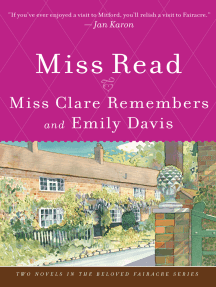
I don’t recall all the Miss Read books I read back then, but I bought my teacher wife a copy that contained her first three novels, Village School, Village Diary, and Storm in the Village, so I think I can assume I’ve read them. And I know I read a number of Thrush Green books as well. This time around, I picked up, Miss Clair Remembers, Emily Davis, Fairacre Festival (a novella), and Summer at Fairacre.
Miss Clair Remembers and Emily Davis are books of little stories that look back on the lives and teaching careers of two good friends, born in the late 1880’s. They tell stories concerning their lives from childhood to old age lived in the English countryside. In these stories Miss Read relates both the beauty of the countryside as well as the hardships and poverty of the people – especially farm workers displaced by economic changes in England at that time. These stories are told in third person, and I found it interesting that they are written more or less in real time. InMiss Clair Remembers, (1962) Miss Clair is retired and her life long friend, Emily Davis is coming to share her cottage with her. Her pending arrival brings about memories of their lives together as children and young adults as well as teachers, though in different schools. Emily Davis, written ten years later (1971) opens with the death of Emily at 80, after sharing the cottage for a decade, and brings about more memories of their life long friendship. There are a number of stories that both book share.
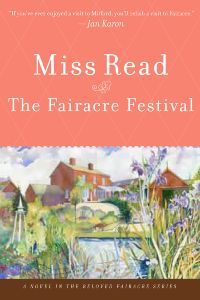
Fairacre Festival (1968) is a novella that relates the efforts of the people of Fairacre to raise money to fix the roof of the local church damaged by a windstorm and a fallen tree. It is told, loosely, in first person. The teacher narrator is the fictional “Miss Read.” I say loosely, as she reports on meeting and conversations that she herself did not attend, so it’s kind of an inner-third person narrative – a story related by Miss Read but often in as a remote observer. It’s a petty slight story. It is interesting that she seems to write the stories as contemporary stories, i.e. the story took place in 1968. One gets the impression that while many things have changed in the southeast English countryside, the old patterns still linger.
Summer in Fairacre (1984) is, I think, Miss Read, after 30 years of writing, is at her best. The story is in first person – Miss Read – a happy spinster, is the head teacher of the two room Fairacre school. She has a married best friend who’s on the lookout for a husband for her. The school janitor is a lady who she’s often at odds with, but recognizes that she’s good at her job, and must take the rough with the smooth. You get to meet all the other regular characters in her stories, and the trials and tribulations of the residents of Fairacre and the neighboring small town. She doesn’t turn a blind eye to the hardships of country life – persistent poverty, abusive husbands, mentally handicapped people, and such, even as she celebrates the beauty of the countryside. This story seems also to be contemporary, and she sees the end of the little school in the not too distant future.
As I mentioned, this story is written in first person, and the person, Miss Read, is a pleasant person to hang around with. She’s kind, thoughtful, has her weakness, and her wit. It makes for a pleasant read, though nothing earthshaking ever happens in the story. If you’re a writer and read the how-to-write articles and such, you’ll have been told to continually ratchet up the tension – to the point where you should even end chapters on little cliffhangers to keep people engaged – at least if you’re writing genre books. Well, this book is pretty much the anti-version of that approach. The story sort of strolls along – it has its mysteries; Miss Read’s married friend disappears for a few days – where has she gone and why? Miss Read is roped into giving a talk before an adult audience; and dreads it. Her janitor takes time off, saying she’s going to quite; who can Miss Read find to replace her? These are cliffhangers in Summer at Fairacre. You don’t read Miss Read for thrills. You read her for the quiet charm of her writing – sprinkled with wit and observations on village life in England. I’m a reader who values and enjoys, light, clever writing, more than the story it tells. So I like Miss Read’s books. If that’s your cup of tea, you might, as well.
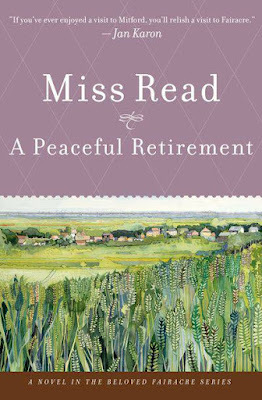
November 12, 2021
The Miss Buncle Books by D E Stevenson
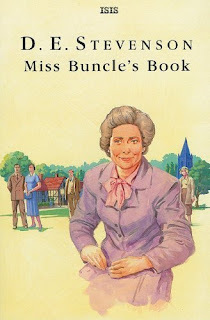 cover credit: https://www.goodreads.com/book/show/1...
cover credit: https://www.goodreads.com/book/show/1...
The reviewer’s bias: I prefer stories with well developed, pleasant characters. I like writing that is clever and witty – entertaining in itself. I prefer first person narratives, or close third person narratives. I dislike thinly disguised fanfic and stories with gaping plot holes.
Not science fiction. As I have mentioned before, I like “little” stories. Stories that concern themselves with issues that, while they may gravely concern the characters, they have no consequences for the world, galaxy, or universe at large. Plus, I am somewhat of an anglophile, and find “old time” life in Britain in the first half of 20th century interesting. In pursuit of that interest I have sought out and enjoy reading light novels about life in Britain in that time period. I recognize that they may not be the most realistic presentation of that life, but since they were written as contemporary fiction at the time, I think that you do get a taste of those now long by-gone times. At one extreme of this type of stories, you have the stories of P G Wodehouse, which no one is likely to take as being anywhere close to realistic. At the other extreme, you have the darker, more literary books by Evelyn Waugh. I prefer reading books on the Wodehouse side of High Street.
Three decades ago or so, I read a number of these light novels of everyday life in Britain, including Miss Read’s Fairacre Novels and Thrush Green stories, as well as a number of books by D E Stevenson. Stevenson wrote over 40 “light romantic novels” beginning in 1923 and up to 1970. The ones I read were rather old books back when I borrowed them from the library and I figured that they would’ve been long purged from library stacks many years ago. But I was wrong. One of the blogs I follow is The Next Fifty http://wanda-thenextfifty.blogspot.com/ It's blogger, Wanda, reviewed Miss Buncle Book. I commented that I was surprised to see that D E Stevenson was still being read, but I guess there is still a readership for those types of stories. Indeed it appears that at least four of them were reprinted only ten years ago or so, the Miss Buncle’s Series of four books. Intrigued, I ordered up all four books from the library, and this is the review of those four books. Having to order them up from various libraries, I read them out of order, but I don’t think it matters much in what order you read them, since the second book’s title is a spoiler for the first book…
cover credit: Amazon.com
Miss Buncle’s Book (1934) Miss Buncle Married (1936) The Two Mrs Abbotts (1943) and The Four Graces (1946)
I don’t like spoilers, so I’ll only outline the stories briefly.
Miss Buncle’s Book tells the story of a single woman in her early 30’s (I’d guess) who lives in the house she grew up in located in the small village of Silverstream. Written during the Great Depression, Miss Buncle finds that the dividends she’s been living on no longer pays the bills. In desperation to generate an income, she decides to write a book, since everyone knows that writing a book is a certain road to fame and fortune. Trust me on that. It was either that or raising chickens. Because she believes that she has no imagination, she bases her story on the people she knows in the village – and all the things she knows and has observed about them, good and bad. She merely changes their names and the name of the village to Copperfield. In her book she describes their ordinary lives, and then has a magical “Golden Boy” come through the village who magically awakens them to their unhappiness. In the books, things happen as a result of this magical intervention.
cover credit:https://www.pinterest.com/pin/2492461...
So much for the book. She keeps it a deep secret, and finds a publisher straight away. She publishes it under the pen name of John Smith, which is a good thing since the book becomes something of a best seller and finds its way to Silverstream. There, the inhabitants recognize themselves in the book and are up in arms about their thinly disguised portraits in it. They want to sue John Smith for libel, and failing that, horse-whip him. However, the book has much the same effect of the Golden Boy in the story. It opens their eyes, and some of the events of the book come more or less to pass, as a result. All this time Miss Buncle is living under the threat of being discovered as the author – though she’s so plain and inconsequential that no one ever suspects her. While this is all going on, she writes a sequel describing the uproar in the village as a result of this book. However, by the time this book is published Miss Buncle, her secret now revealed, has found a love and slipped away with her new husband.
So much for the plot. The story, like all the others in this set, is written in omnipresent 3rd person, which is my least favorite style. Most of us live our lives in first person singular, and that style seems to me to be the most natural way to tell a story. I don’t like being a god and looking down on the characters as they move inevitably to their reward or doom. However, D E Stevenson’s third person is not a god, but a village nosy-parker/gossip. You get to know everyone involved. Each has their little stories woven in throughout the story. But it’s a ground level view of them, almost as if you knew them from gossip, so I didn’t mind her style at all. And well, clearly she was having fun writing this novel about a novice writer. There are lots of intricately moving parts in this story which kept me reading and looking forward to reading more of it.
cover credit: https://www.abebooks.com/servlet/Sear...
Miss Buncle Married takes up her story two years later. She and her husband move to a new little town and once again we are treated to D E Stevenson’s exploration of different types of people. The title character has matured and become more sophisticated – somewhat unconvincingly, but no matter. There are less moving parts in this book. The romance of her husband’s nephew is a prominent element of the book. It is resolved a little too neatly, in my opinion, but still the book is entertaining, if not quite up to the standard of the first one. (I read this one first, and enjoyed it, so it’s good, just not as good as the first story.)
cover credit: https://www.goodreads.com/book/show/2...
The Two Mrs Abbotts is set something like seven years later, in the middle of World War ll. The title characters are Barbara Abbott (nee Buncle) and the wife of her husband’s nephew, who is now away fight in the war in North Africa. In this story we get a little portrait of life during the war in England, and a variety of sub-plots. The romantic sub-plot this time around revolves around a popular romance novelist who has suddenly become disenchanted with her work, and so she takes a holiday, boarding with the younger Mrs Abbott to escape her older sister who is her agent, business manager, and publicity agent who wants her to continue writing and earning them money.
cover credit: https://thecaptivereader.com/2013/06/...
The Four Gracesshares a few characters from the last two books, but is otherwise a different story altogether. It tells the story of a vicar with four daughters in their 20’s, with a romance or two and various trials and tribulations set in the last year or so of World War ll. Once more you get to know the various characters, though fewer this time than the previous stories. This was probably my second favorite book of the set.
As I said way back in the introduction to these little reviews, I like to read this type of story to get an idea of what everyday life was like when these were contemporary stories. These books had a curious takeaway. Class. (Upper?) Middle class. Almost all the named character in these stories either employed at least one servant, and more likely more, or were servants themselves. Even the poor Miss Buncle employed her old nurse/nanny as her housekeeper, who did all the cooking and cleaning for her. Miss Buncle might potter around in her garden, but it was her old servant who did all the house work, cooking, and tea making in the house. And the same for all her associates. I am sure that there were many more people in the village, but we only get to know the class of people wealthy enough to employ servants. And these aren’t people living in country homes. They were pretty much middle class people, with husbands that worked or their widows.
Married Miss Buncle employs not only her old nanny, but a husband and wife team to keep the house and garden. And when she has her children, her old nanny is once again a nanny to her children. She spents her day visiting neighbors, going or hosting teas, and going out to dinner. She would sometimes go up to the nursery and have tea with her children. Not only was I struck by the extensive use of servants in modestly wealthy households, but eighty years later, I was also struck by the idleness of these women’s lives. Of course I don’t know how authentic a portrait of this class these books are, they are fiction, after all, but I’m sure there is some truth in them. I suspect that D E Stevenson drew on her lifestyle for her books.
One other thing struck me – her treatment of lower class Londoners, driven to the countryside by the blitz and their children. They are portrayed rather condescendingly, as dirty, lazy, ignorant, or selfish. The children, if raised properly in the countryside, could be taught to be proper domestic servants. Though, in the end, she usually gives them some good characteristics, acknowledging that they are a product of a hard life.
Clearly these books are not everyone’s cup of tea. Probably not yours. But I enjoyed them. Indeed, I’m reading some Miss Read stories now. I may review them at a later date.

